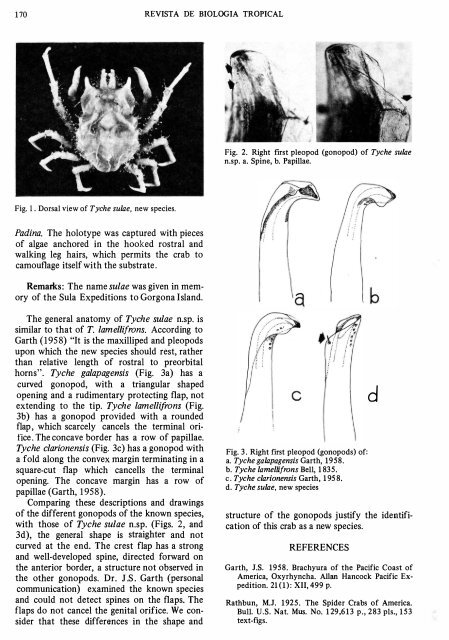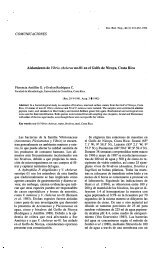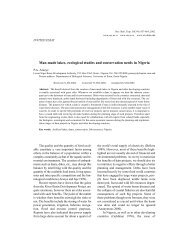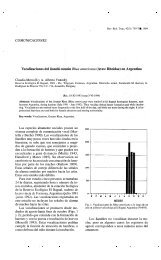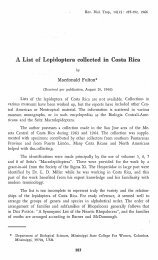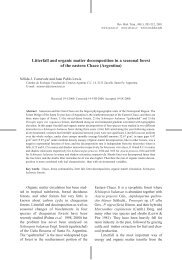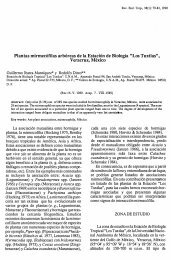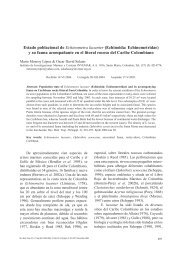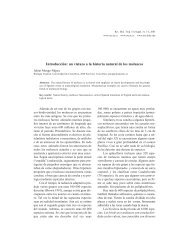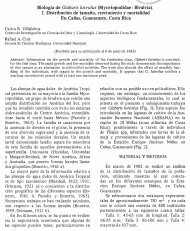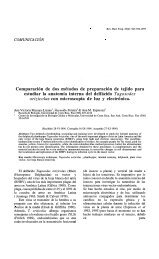a new spider crab from Gorgona Island, Colombia Henry von Prahl ...
a new spider crab from Gorgona Island, Colombia Henry von Prahl ...
a new spider crab from Gorgona Island, Colombia Henry von Prahl ...
You also want an ePaper? Increase the reach of your titles
YUMPU automatically turns print PDFs into web optimized ePapers that Google loves.
170<br />
Fig. l. Dorsal view of Tyche sulae, <strong>new</strong> species.<br />
Padina. The holotype was captured with pie ces<br />
of algae anchored in the hooked rostral and<br />
walking leg hairs, which permits the <strong>crab</strong> to<br />
camouflage itself with the substrate.<br />
Remarks: The name sulae was given in memory<br />
of the Sula Expeditions to <strong>Gorgona</strong> <strong>Island</strong>.<br />
The general anatomy of Tyche sulae n.sp. is<br />
similar to that of T. lamellifrons. According to<br />
Garth (1958) HIt is the maxilliped and pleopods<br />
upon which the <strong>new</strong> species should rest, rather<br />
than relative length of rostral to preorbital<br />
horns". Tyche galapagensis (Fig. 3a) has a<br />
curved gonopod, with a triangular shaped<br />
opening and a rudimentary protecting flap, not<br />
extending to the tipo Tyche lamellifrons (Fig.<br />
3b) has a gonopod provided with a rounded<br />
flap, which scarcely cancels the terminal oririce.<br />
The concave border has a row of papillae.<br />
Tyche clarionensis (Fig. 3c) has a gonopod with<br />
a fold along the convex margin terminating in a<br />
square-cut flap which cancells the terminal<br />
opening. The concave margin has a row of<br />
papillae (Garth, 1958).<br />
Comparing these descriptions and drawings<br />
of the different gonopods of the known species,<br />
with those of Tyche sulae n.sp. (Figs. 2, and<br />
3d), the general shape is straighter and not<br />
curved at the end. The crest flap has a strong<br />
and well-developed spine, directed forward on<br />
the anterior border, a structure not observed in<br />
the other gonopods. Dr. J.S. Garth (personal<br />
communication) examined the known species<br />
and could not detect spines on the flaps. The<br />
flaps do not cancel the genital orifice. We consider<br />
that these differences in the shape and<br />
REVISTA DE BIOLOGIA TROPICAL<br />
Fig. 2. Right fl fst pleopod (gonopod) of Tyche sulae<br />
n.sp. a. Spine, b. Papillae.<br />
Fig. 3. Right fl fst pleopod (gonopods) of:<br />
a. Tyche galapagensis Garth, 1958.<br />
b. Tyche lamel/ifrons Bell, 1835.<br />
C. Tyche clarionensis Garth, 1958.<br />
d. Tyche sulae, <strong>new</strong> species<br />
b<br />
d<br />
structure of the gonopods justify the identification<br />
of this <strong>crab</strong> as a <strong>new</strong> species.<br />
REFERENCES<br />
Garth, J.S. 1958. Brachyura of the Pacific Coast of<br />
America, Oxyrhyncha. Allan Hancock Pacific Expedition.<br />
21 (1): XII, 499 p.<br />
Rathbun, M.J. 1925. The Spider Crabs of America.<br />
Bull. U.S. Nat. Mus. No. 129,613 p., 283 pis., 153<br />
text-figs.


